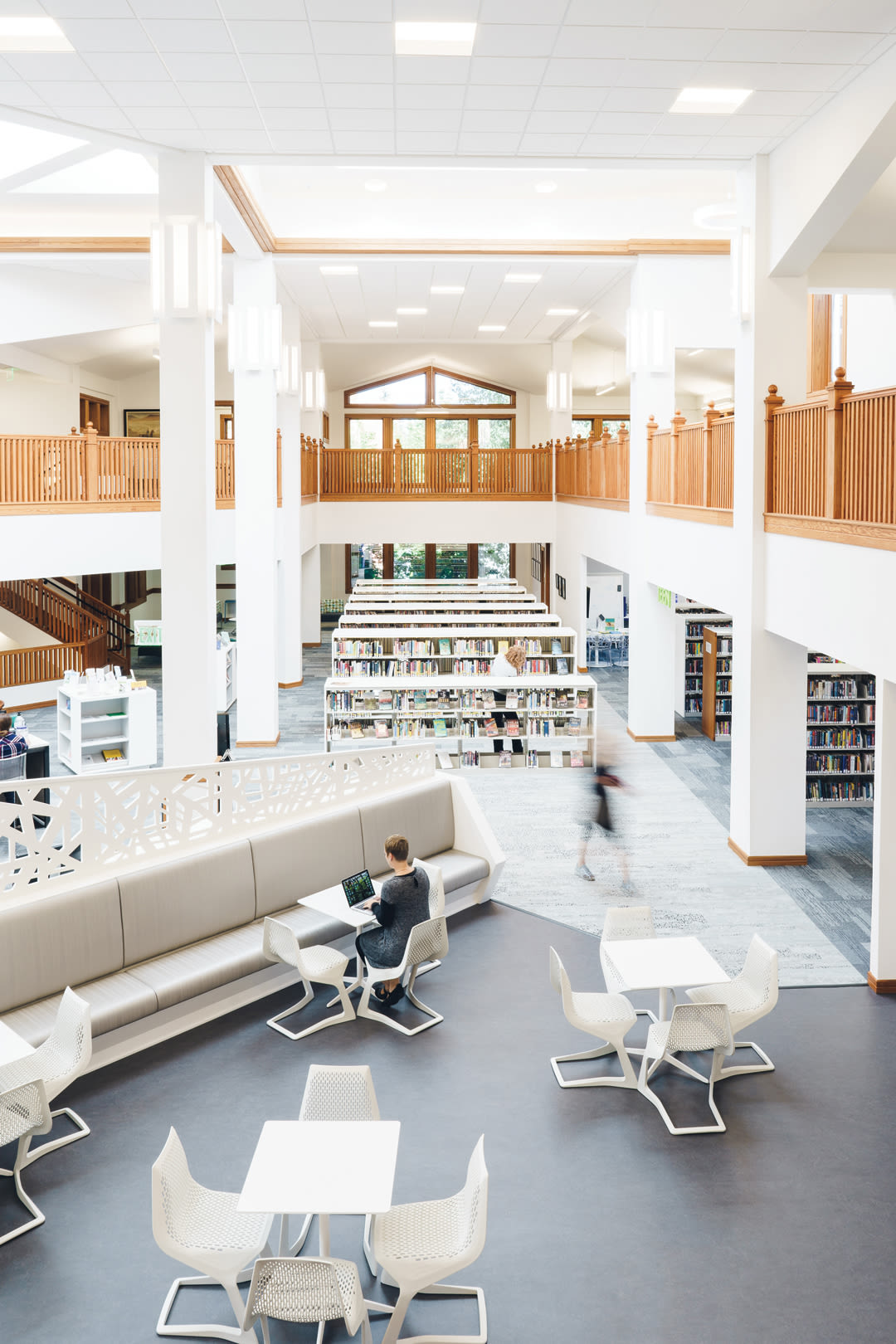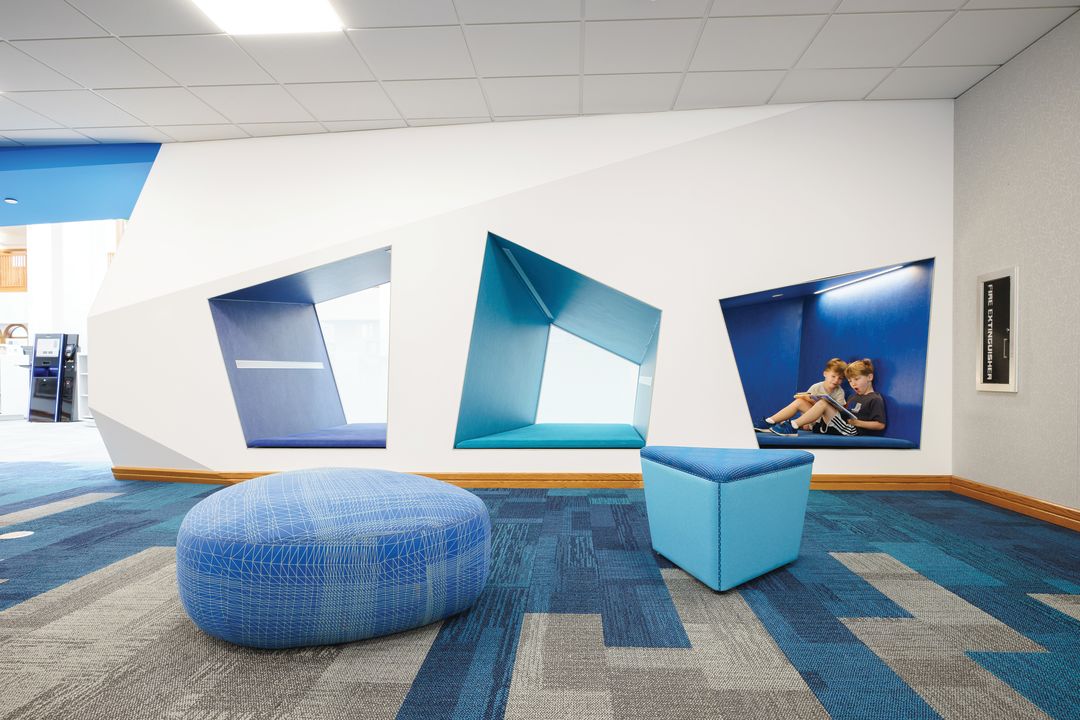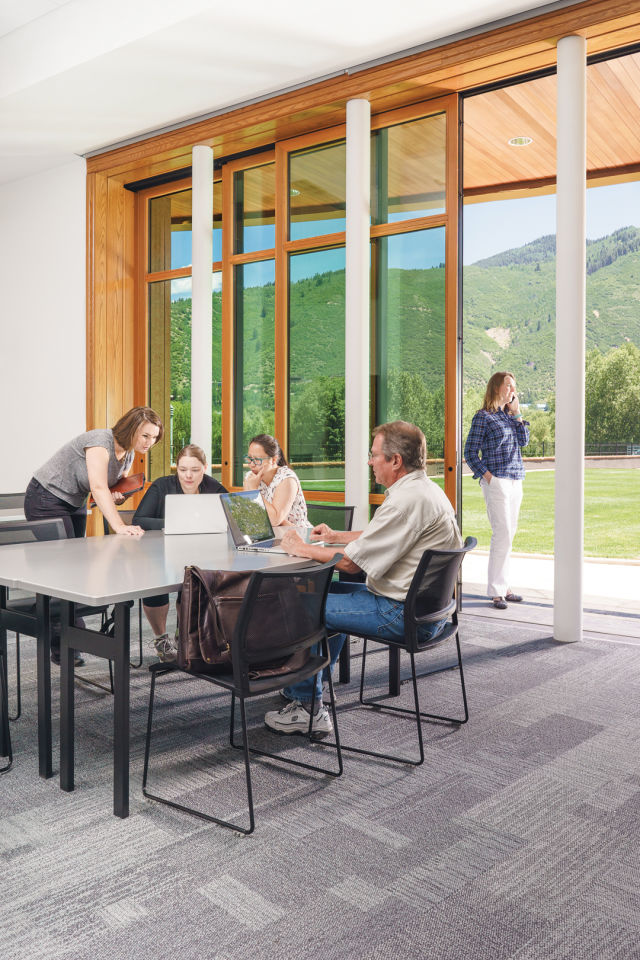The Pitkin County Library Checks in to the 21st Century With a Modern Refresh

The library’s main level; the overlapping line pattern on the divider atop the benches was inspired by ski tracks in snow.
Librarian Kathy Chandler typically receives two reactions from visitors seeing the new and improved Pitkin County Library for the first time. First is admiration for how light and bright the space appears. The second: “Where did all the books go?”
It’s a valid question. Previously, books were stacked almost eight feet tall, obscuring views toward Red Mountain and the ample skylights in place since the building’s construction in 1991. In fact, when noted library design consultant Susan Kent toured the Aspen facility in 2008, she declared, “My, what high stacks you have!”
Also front and center on the main floor were banks of clunky desktop computers, installed more than 20 years ago to steer patrons into the digital age, faced by a long circulation desk occupying an inordinate chunk of real estate.
To reconfigure and expand the property to serve the community’s changing needs, the board selected Minneapolis-based MSR Design, which specializes in libraries, and Vail-based lead architect Snowdon and Hopkins. The 18-month renovation was completed in June.
“Now the focal point is on collaborative study more than a warehouse of books,” Chandler says. Inspired by a village green, the revamped main level includes a Library Lab with content-creation spaces—a green-screen room, sound booth, and 3D-printing lab—flanked by a vending machine café, group meeting rooms, and a teen room. Self-checkout kiosks, which debuted during the library’s temporary relocation to the former Aspen Art Museum site, free up staff to handle other queries from smaller perches throughout the room. (Chandler estimates that some 3,000 items per week are checked out via the machines.)
Since Kent had identified that the most popular parts of the collection were located in the hardest-to-reach areas, the library’s extensive electronic media cache—including one of Colorado’s largest CD compilations, as influenced by the Aspen Music Festival and School—was moved up from the dim, low-ceilinged basement to the main floor. Meanwhile, those lofty book stacks were slashed to a wheelchair-accessible 66 inches and relocated to the building’s lower and upper levels. Also on the main floor are new-release book displays, serving as clear reminders that this is a bibliotheca still.

Reading nooks in the children’s area evoke abstract blocks of ice.
The children’s room, formerly on the lower garden level, its entrance just steps from Mill Street, may have been the most-trafficked expanse—it served as a pedestrian shortcut to other parts of the library. Safety was key in MSR’s decision to move the kid-centric space to the back corner of the main floor, part of a 5,108-square-foot addition. Now, diminutive reading nooks resemble abstract blocks of ice, and activity zones for early learners infuse the sun-filled space with color. Past the library’s lockable doors and up a few stairs is the William R. Dunaway Community Room, featuring cutting-edge audio-visual equipment and an enjoyably distracting view of Smuggler Mountain through floor-to-ceiling windows.The layout represents a 21st-century trend in library design. “Libraries today are about connection,” notes Traci Lesneski, principal and interior designer of MSR and chair of the Architecture for Public Libraries Committee for the American Library Association. “Increasingly, that space is giving way to more places to meet and to create content, not just consume it.”
The mezzanine level upstairs holds the fiction collection, a tutoring area that serves some 85 volunteers for English in Action, among others, and collections of magazines, newspapers, and Spanish-language tomes. The basement stores everything else: nonfiction, reference materials, a growing audiobook collection, and staff offices.

The William R. Dunaway Community Room.
Much of the $14.3 million price tag (almost all of it raised through donations; a 2012 ballot measure for city funding was rejected) funded eco-friendly upgrades: carpeting, paint, insulation, energy-saving lighting, water bottle-filling stations, and roof repair that added bioswales to collect and reuse rainwater.
Unsurprisingly, Aspen’s stunning outdoor environment provided plenty of inspiration. “Materials and fabrics on furniture are all drawn from colors found in nature—berries from juniper trees, icy snow—tempered by existing oak wood that is prevalent throughout,” Lesneski says.
Seating was a priority, too. “Making sure all users—from the ultra-rich to the homeless—felt comfortable in a public building was very much on our minds,” she adds. “It was not a one-size-fits-all approach.”
Mission accomplished—the new Pitkin County Library boasts some 37 styles of vibrant chairs, couches, and benches, all the better for admiring the views.
Fun Facts From Pitkin County Library
Most checked-out book at the Pitkin County Library: Curious George Gets a Medal, by H.A. Rey
Most well-stocked book: Aspen: The History of a Silver Mining Town, 1879–1893, by Malcolm J. Rohrbough
Oldest book: Annual Report of the United States Geological and Geographical Survey of the Territories: Embracing Colorado, Being a Report of Progress of the Exploration for the Year 1873
Most frequently asked question at the reference desks: “Where can I find info on local mushrooms, wildflowers, and hiking trails?”













































